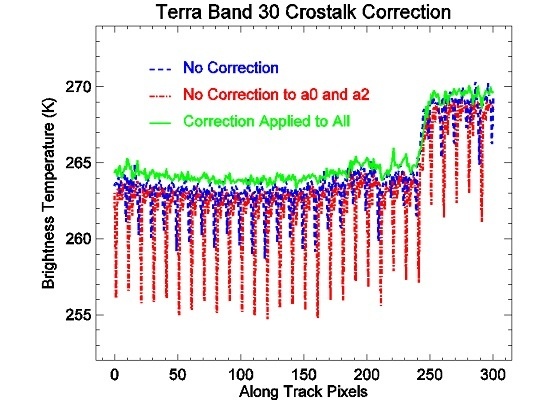Investigation and Mitigation of the Crosstalk Effect in Terra MODIS Band 30
Abstract
:1. Introduction
2. Correction Algorithms and Coefficients
2.1. Crosstalk Algorithm
2.2. Crosstalk Coefficients
3. Crosstalk Correction in BB Calibration
3.1. Impact on Non-Linear Coefficients
3.2. Impact on Linear Term
4. Crosstalk Correction in L1B EV Products
4.1. EV Imagery
4.2. EV Radiometry
5. Conclusions
Acknowledgments
Author Contributions
Conflicts of Interest
References
- Xiong, X.; Chiang, K.; Esposito, J.; Guenther, B.; Barnes, W. MODIS On-Orbit Calibration and Characterization. Metrologia 2003, 40, 89–92. [Google Scholar] [CrossRef]
- Xiong, X.; Butler, J.; Wu, A.; Chiang, V.; Efremova, B.; Madhavan, S.; Mcintire, J.; Oudrari, H. Comparison of MODIS and VIIRS onboard blackbody performance. Proc. SPIE 2012, 8533. [Google Scholar] [CrossRef]
- Sun, J.; Madhavan, S.; Wenny, B.; Xiong, X. Terra MODIS band 27 electronic crosstalk: Cause, impact, and mitigation. Proc. SPIE 2011, 8176. [Google Scholar] [CrossRef]
- Sun, J.; Xiong, X.; Madhavan, S.; Wenny, B.N. Terra MODIS Band 27 Electronic Crosstalk Effect and Its Removal. IEEE Trans. Geosci. Remote Sens. 2014, 52, 1551–1561. [Google Scholar]
- Sun, J.; Xiong, X.; Li, Y.; Madhavan, S.; Wu, A.; Wenny, B.N. Evaluation of Radiometric Improvements with Electronic Crosstalk Correction for Terra MODIS Band 27. IEEE Trans. Geosci. Remote Sens. 2014, 52, 6497–6507. [Google Scholar]
- Madhavan, S.; Sun, J.; Xiong, X.; Wenny, B.N.; Wu, A. Statistical Analysis of the Electronic Crosstalk Correction in Terra MODIS Band 27. Proc. SPIE 2014, 9218. [Google Scholar] [CrossRef]
- Sun, J.; Madhavan, S.; Xiong, X.; Wang, M. Electronic crosstalk correction for terra long wave infrared photovoltaic bands. Proc. SPIE 2014, 9264. [Google Scholar] [CrossRef]
- Sun, J.; Madhavan, S.; Xiong, X.; Wang, M. Investigation of the Electronic Crosstalk in Terra MODIS Band 28. IEEE Trans. Geosci. Remote Sens. 2015, 53, 5722–5733. [Google Scholar]
- Sun, J.; Madhavan, S.; Xiong, X.; Wang, M. Electronic crosstalk in Terra MODIS thermal emissive bands. Proc. SPIE 2015, 9607. [Google Scholar] [CrossRef]
- Madhavan, S.; Xiong, X.; Sun, J.; Chiang, K.; Wu, A. Electronic crosstalk characterization of Terra MODIS long wave infrared channels. Proc. SPIE 2015, 9607. [Google Scholar] [CrossRef]
- Sun, J.; Madhavan, S.; Xiong, X.; Wang, M. Long-term trend induced by Electronic Crosstalk in Terra MODIS Band 29. J. Geophys. Res. Atmos. 2015, 120, 9944–9954. [Google Scholar] [CrossRef]
- Xiong, X.; Wu, A.; Wenny, B.N.; Madhavan, S.; Wang, Z.; Li, Y.; Chen, N.; Barnes, W.; Salomonson, V. Terra and Aqua MODIS Thermal Emissive Bands on-orbit Calibration and Performance. IEEE Trans. Geosci. Remote Sens. 2015, 53, 5709–5721. [Google Scholar] [CrossRef]
- Wenny, B.N.; Xiong, X.; Madhavan, S. Evaluation of Terra and Aqua MODIS thermal emissive band calibration consistency. Proc. SPIE 2012, 8533. [Google Scholar] [CrossRef]


















© 2016 by the authors; licensee MDPI, Basel, Switzerland. This article is an open access article distributed under the terms and conditions of the Creative Commons by Attribution (CC-BY) license (http://creativecommons.org/licenses/by/4.0/).
Share and Cite
Sun, J.; Madhavan, S.; Wang, M. Investigation and Mitigation of the Crosstalk Effect in Terra MODIS Band 30. Remote Sens. 2016, 8, 249. https://0-doi-org.brum.beds.ac.uk/10.3390/rs8030249
Sun J, Madhavan S, Wang M. Investigation and Mitigation of the Crosstalk Effect in Terra MODIS Band 30. Remote Sensing. 2016; 8(3):249. https://0-doi-org.brum.beds.ac.uk/10.3390/rs8030249
Chicago/Turabian StyleSun, Junqiang, Sriharsha Madhavan, and Menghua Wang. 2016. "Investigation and Mitigation of the Crosstalk Effect in Terra MODIS Band 30" Remote Sensing 8, no. 3: 249. https://0-doi-org.brum.beds.ac.uk/10.3390/rs8030249






